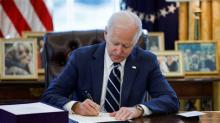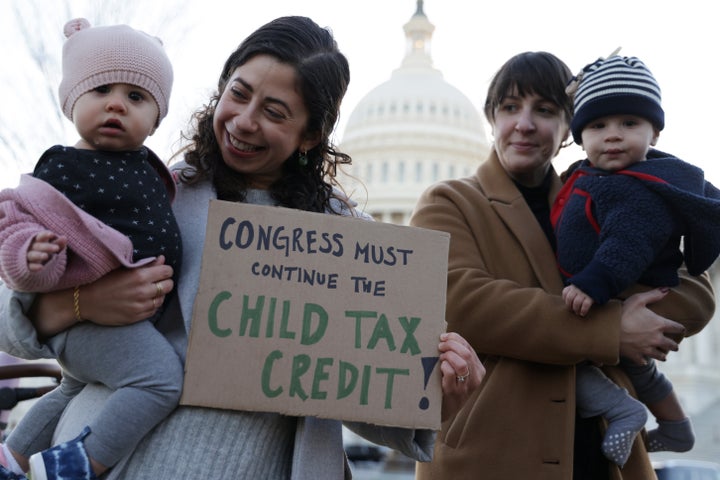
WASHINGTON — Poverty fell to a new low last year thanks to new federal spending passed in response to the coronavirus pandemic, according to new federal data released Tuesday.
Extra unemployment benefits, stimulus checks and a monthly child allowance helped push the poverty rate to 7.8% in 2021, according to an annual Census Bureau poverty measure that accounts for tax benefits and stimulus payments. The rate had been 9.1% in 2020.
The monthly child benefit slashed child poverty to 5.2%. Both the overall and child poverty figures are the lowest on record, officials said.
“Refundable tax credits, including the child tax credit, kept 9.6 million people out of poverty in 2021,” the Census Bureau’s Liana Fox told reporters on Tuesday.
Democrats included the various relief policies in a $1.9 trillion bill called the American Rescue Plan, which passed Congress on a party-line basis in March 2021. The bill represented Democrats’ vision of a more humane political economy that better supports parents and laid-off workers.
The bill provided $1,400 stimulus checks to most Americans, added $300 to weekly unemployment benefits, and gave parents as much as $300 per minor child each month from July through December.
Republicans pilloried the Rescue Plan as too much spending on an economy that was already improving, and they have blamed it for the record price inflation that has tanked consumer sentiment this year. Economists have said that yes, the bill did contribute to inflation, though there’s an ongoing debate over how much prices would have risen anyway due to pandemic-related supply chain problems. The Census Bureau’s “official” poverty measure, which doesn’t factor expenses, omits key sources of income, and fails to account for geographical differences in costs such as rent, showed a slight increase last year from 11.4% to 11.6%, which officials said was not a statistically significant change. Though it’s outdated as a poverty measure, the federal government uses the official threshold — $27,740 for a family of four last year — to set eligibility for various federal programs, such as food benefits. Democrats celebrated early estimates suggesting that their temporary changes to the child tax credit, which provided monthly payments to parents in the second half of last year, produced a record decline in child poverty. Still, inflation has remained a top concern for voters. But Tuesday’s release from the Census Bureau showed that early estimates showing a sharp drop in child poverty were right. The supplemental poverty measure, which accounts for tax benefits, showed that child poverty declined from 9.7% in 2020 to 5.2% last year, the decline resulting almost entirely from the six rounds of monthly payments. “It is pretty stunning,” Indivar Dutta-Gupta, president of the Center for Law and Social Policy, said in an interview. “This was obviously a very well designed and targeted program if your goal was to keep kids out of poverty.” The Census Bureau has only published its supplemental poverty rate since 2009, but experts at the liberal Center on Budget and Policy Priorities and the Columbia Center on Poverty and Social Policy have said the 2021 child rates would still be the lowest on record according to their analysis of historical data. The vast majority of American families automatically received the child tax credit payments as advance monthly checks from the IRS starting last July, even if they had little or no income and therefore no federal tax burden. “We knew that this was the greatest policy impacting levels of child poverty in the nation’s history,” Sen. Cory Booker (D-N.J.) told HuffPost on Tuesday. “It’s an extraordinary breakthrough.” But the lack of an income requirement ― the same thing that made the policy so effective at reducing child poverty ― proved an insurmountable political obstacle. Sen. Joe Manchin (D-W.Va.) refused to go along with a planned continuation of the payments last December, complaining to his colleagues that his constituents told him parents wasted the money on drugs. Democrats have said they may try to negotiate with Republicans to revive the monthly benefit in some form, though such a deal is unlikely to come together anytime soon. Republicans, for their part, didn’t have much to say about low child poverty last year. “You can always end poverty by taking money and just giving it to people that are poor, which is a nice thing to do, but not going to solve the problem long term,” Sen. Mitt Romney (R-Utah) told HuffPost. Sen. John Barrasso (R-Wyo.) answered a question about child poverty by talking about inflation. The Bureau of Labor Statistics reported Tuesday that inflation had once again risen in August. “Three-quarters of families say they are stressed by inflation under Biden and the Democrats, which is why we’re going to continue to talk about that,” Barrasso said.

